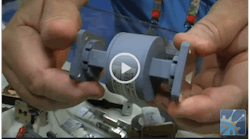Microtech’s Jim McGregor works on solutions for those who need a radar dish to turn. There are two different rotary waveguides he exhibits that can solve this problem. The first adapts from rectangular waveguide to a coaxial structure on one side, back to a rectangular waveguide on the other—allowing it to turn. The advantage here is rotary motion and broadband, while the disadvantage is a chain of coax in the center. There is a large electrical cost in adapting from rectangular to coax and back to rectangular, and it won’t handle as much power. The second option is to change the structure from rectangular to circular back to rectangular, allowing it to handle much more power. Unlike the former, however, it is narrowband.
The third solution is a torsional joint, which stays within waveguide structure but will not go 360 degrees. With torsional joints, higher frequency has smaller openings. The vertebrae on the inside are proportional, allowing them to engage at the same time. Although not made to twist to 360 degrees, adding vertebrae can increase rotation. While a rotary joint is not needed with this, it can be used at 90 degrees, 180 degrees, etc. While this seems limiting, the advantage is that power is not a problem as it stays in the waveguide structure and does not have to convert to a coaxial or circular structure.
Watch the video above for a preview of Microtech’s rotary and torsional waveguides, and check out other videos from IMS 2014 at Engineering TV.
